My first full day in the UAE was a Friday. I didn’t realize it at the time, but the weekend in the UAE is Friday and Saturday, not Saturday and Sunday. The CIEE seminar didn’t begin until 2:00 pm. Having sat around on planes for the last day and a half, I wanted to get out. So, I went for a walk. Not realizing that Friday is the weekend, I assumed stores and banks would be open. No such luck. Everything was closed, including the Metro (their subway) until later in the day. In Islam, Friday is traditionally the day you visit the mosque. And since the UAE is, as I would learn repeatedly throughout my stay, a driving city and not a walking city, that meant that they closed the Metro. I could see the Burj Khalifa, the world’s tallest building, from my hotel, which was at the end of the financial center strip. With several hours to kill, I started walking toward the Burj Khalifa just to see what I could see. Along the way I noticed that all the stores were closed and there was no one out and about. I also tried to get money out of an ATM, but it was an Indian bank and they didn’t recognize my debit card. The city seemed very empty.
The layout of the city is also very different. Basically there is one major freeway that runs the length of the coast in the UAE, Sheik Zayed Road, connecting the emirates. My hotel was just off a frontage road that runs parallel to the major freeway. I was worried based on a book I read prior to leaving for Dubai, City of Gold by Jim Krane, that walking around would be very dangerous and there would be no sidewalks. While the sidewalks are a bit spotty and walking around can be dangerous, it really wasn’t that bad. I walked along Sheik Zayed Road for about 2 miles until I was basically perpendicular to the Burj Khalifa. I then used the Metro station to cross over the main road and found an ATM in the Metro that recognized my debit card. Here’s a photo from the Metro station of Sheik Zayed Road:

I asked a security guard in the Metro station when the Metro opened and he said at 1:00 pm. Since I was already there, I figured I’d keep walking, so I continued heading toward the Burj Khalifa (FYI – “burj” means tower and “Khalifa” is the name of the President of the UAE who bailed Dubai out when the economic recession hit). I only took my phone with me, so photos from that first walk weren’t very good, but I snapped a few. Here’s one of me in front of the Burj Khalifa:
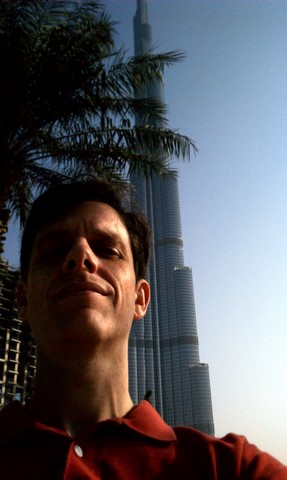
I walked around the tower and ran into security on one side which informed me that there were private residences there, so I couldn’t enter. I walked around a bit more, then tried to walk back to my hotel on the other side of the main road as I had seen a grocery store that was open and I thought it would be a good idea to have some snacks with me. Dubai really is not all that walker friendly. Construction on that side of the main road had torn up any semblance of a place to walk. So, I ended up walking through construction sites until I found the grocery store. I also hadn’t caught what the exchange rate was yet, so when I saw the prices in the store I couldn’t believe them – 14 dirham for a bag of granola. Turns out the exchange rate was 3.6 dirham to the dollar, which meant the granola was still pricey at close to $4.00, but not as bad as I thought. Also, the grocery store basically carried Western products and goods, along with some local stuff, but Westerners would be able to find pretty much whatever they would need to cook and eat in the supermarkets here. I bought some granola and fruit then climbed over more construction until I got to another Metro station and could use that to cross the main road. I then headed back to my hotel. Not knowing where we were going to go for dinner, I ate lunch in the hotel restaurant, then took a nap and got ready for the seminar to begin.
I finally met the rest of the group at 2:00 pm. There were 10 of us: “C” from Rhode Island, “L” from Connecticut, “R” from Georgia, “JS” from Nebraska, “K” from North Carolina, “M” from Massachusetts, “JL” from Indiana, “D” from Kansas, and “G” from Tennessee (I’m not using their names to protect their identities; they may not want me to share some information about them on here). We informally did very quick introductions then jumped into our tour van. Everyone seemed nice, but I naturally gravitated toward the next youngest person there – K. While almost 20 years older than I am, he was the closest to me in age and it turned out we had a lot of similar interests.
From the hotel we drove to Old Dubai, specifically an area called Heritage Shindagha Village. Recently the governments of two of the wealthier emirates – Dubai and Sharjah – have realized that their demolition of the historic homes in the area have largely destroyed the heritage of the native Emiratis. One of the drawbacks of this is that it makes it even harder to know what the identity of Emiratis is – they are struggling to figure this out. Without historical homes and much of a connection to history, that connection to a possible historic identity has been lost. However, the governments in these two emirates have begun to reconstruct some of the older homes. Shindagha Village and another location nearby, Bastakiya, are restoration projects in Dubai aiming to accomplish this. The government of Dubai has funded excavations and reconstructions of what the homes may have looked like before modern development. We walked around some of the reconstructions and were guided by Samia Rab, an architecture professor at American University of Sharjah (AUS).
One of the most notable aspects of the architecture that, while not unique to the UAE (it’s Iranian, if I remember correctly), is their design for wind towers. There is only one traditional wind tower functioning in the UAE today according to Dr. Rab, though some variations on these towers do exist (I’ll describe one later). Here’s a picture of the recreated wind towers in Shindagha Village:
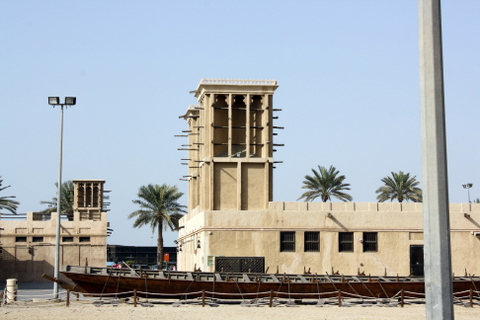
How they work is interesting. They are up above the house and were only used in homes that didn’t have large courtyards as courtyards have a similar cooling effect. At the bottom of the wind tower is a low hanging boundary that drops from the ceiling. The bottom of the wind tower opens into a sitting room with windows leading to the courtyard. As the wind blows, it hits the wind tower and travels down the tower. As the air is pushed out of the windows in the sitting room and then out of the courtyard, the air coming in from the wind tower cools pretty dramatically. Dr. Rab noted that tests had found the temperature of the air can drop by as much as 18 degrees, which would make a big difference in the horrific heat of the gulf during the summer (120 to 130 degrees F). The low hanging barrier pushes the air very low, allowing it to rise slightly after falling and accentuates the cooling. I have to admit to not understanding the physics and engineering involved, but we did visit the working wind tower (I’ll posts pictures later) and it does work. It’s pretty amazing, actually. The buildings are largely constructed of a stucco-like mud filled in with coral from the sea bed. I’ll post pictures of this later as we visited some ruins that clearly exposed the coral.
We walked through the reconstructed homes and ended up at a small cafe/art store in that area. That is where we first had mint lemonade. The version they served in that cafe was really strong – probably too strong – but still good. Here’s a picture:

After our drink we walked along the Creek (or river) that serves as a prominent characteristic of old Dubai. Right next to the Creek is a “souk” or market. There are actually three, one on the Bastikiya side and two on the other. The one we walked through on the Bastikya side was the textile souk, which I later visited again to shop for some souvenirs for Debi and Toren. It was a nice little market with small stores and hawkers out front trying to get you to buy their wares, the most prominent item being pashmina scarves. Here’s a photo of the souk:
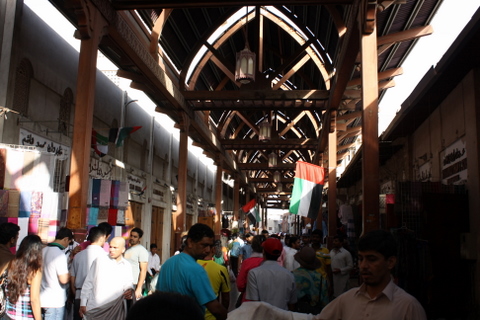
On the Creek were the abras or water taxis, which are motor powered wooden boats that ferry people across the Creek for 1 dirham (about $0.30). Here’s a photo of one:
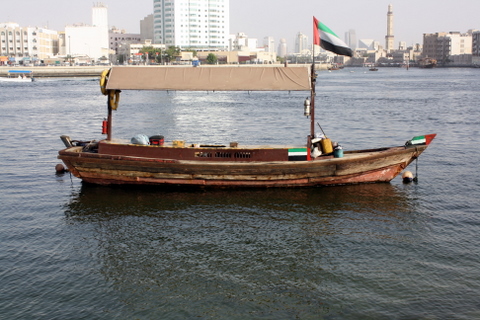
On the far side are spice and gold souks. The Sheikh of Dubai, Sheikh Mohammad, also has his Ruler’s Court along the Creek, which apparently involved the destruction of lots of homes to build. We also walked up to the old fort in Dubai, as well as to a mosque. I really liked the Old Dubai area. It isn’t the glitz and glamour of the modern high rises; it seemed more authentic. And even though the souks are touristy, it seemed like locals gravitated to this area as well. We walked through an open area that was filled with Emiratis and ex-patriots just hanging out. There were also restaurants on the side of the Creek, which made for relaxing eating (we went later).
From Bastakiya, we got in the van and headed toward the famous Palm Jumeira – the human-made island in the shape of a date palm tree (with a breakwater). We stopped on the way at Jumeira Beach to catch a view of the world’s only 7-star hotel – Burj Al Arab. The air quality in Dubai isn’t great and the smog made getting good pictures difficult, but here’s one of the photos I took from the beach:

We also stopped at Souk Madinat, which offered nice views of Burj Al Arab, but also contained a much higher scale souk (no bargaining there, unlike in the textile and spice souks). The part that struck me the most were the Christmas decorations. Islam is the official religion of the UAE. While there are, no doubt, some Christian ex-patriots, I found it highly unlikely that the lights, wreaths, Christmas decorations, and even Christmas tree were put up just to make ex-patriots or even tourists comfortable (which is what one of our guides suggested). This was in fact just the type of thing I was looking for as a sociologist studying secularization. What it suggests to me is two things: First, Christmas has outgrown Christianity; it is now a secular holiday that involves specific decorations, shopping, and other activities that are likely culture specific – family gatherings, going to the movies, etc. Christmas doesn’t have to be about Christ; it exists independent of him. (I am, of course, ignoring here the fact that Christmas is the result of syncretism from other religions that predate Christianity.) The second thing I thought was interesting was that the owners of this shopping area are pretty likely to be Muslims. While Christians in the US are fine letting, say, Jews, celebrate their own holidays, they do not typically decorate specifically for those holidays in order to attract them to their stores. Maybe there are the occasional menorahs in stores around Hannukah, but that seems pretty rare. I can’t even imagine Christians trying to decorate for a Muslim holy day in order to attract them to shop on those days. But what I saw in the UAE was Muslims decorating their shops in ways that have, for the last century or two, been associated with Christianity in order to attract shoppers. Admittedly, the holiday and decorations have been divorced from Christianity, as noted above. But this also says to me that, at least for some Muslims in the UAE, profit comes before religion, as they are willing to superficially celebrate the holy days of other religions in order to increase business. Religious fundamentalists – Muslim or Christian – would never do that; that would be seen as tolerating the religion of the infidel. If my assumption is correct that the owners of that Marina are Muslims, then they are secularizing. This may not be the best motivation for doing so, but it is evidence that it is occurring. Anyway, we didn’t stay long at the souk, but I snapped a photo of the Christmas tree because I had to.
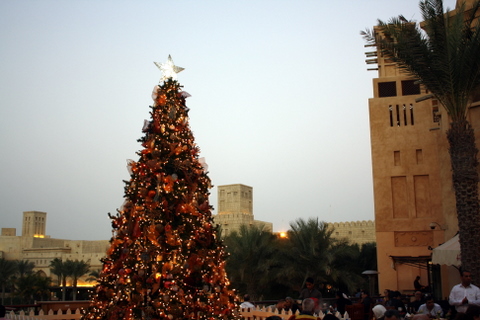
From there we drove out to the Palm Jumeira and then to the breakwater where the Atlantis Resort is located. Our guide had arranged dinner for us in a buffet in Atlantis, Saffron. On the way out to Atlantis and on the way back to our hotel we all noticed that most of the condos on Palm Jumeira were dark (it was night, so lights should have been on). Maybe this was because people were out – Emiratis do go out at night, late into the night. But given that more than 3/4ths of the condos were dark, that seemed like a lot. It may also be the case that some of the condos are only used part of the year. But the most likely explanation is that the condos are actually empty – there is no one in the condos. When the Palm Jumeira was originally announced, it sold out very quickly and property values went up rapidly. Many of those buying property bought it as an investment just to flip it. With the economic recession and the bubble in home prices popping – in the UAE too – the values of the homes and condos on the island have fallen by as much as 2/3rds, if not more. The result is more condos and homes than there are people for them – at least more exclusive homes for wealthy individuals.
This wasn’t the first indication that Dubai is over-built. As I walked around town earlier in the day I saw in huge letters on lots of high rises “To LET” followed by a phone number. If property were in such demand, why are there so many units that are available? Despite this, new buildings are going up. I’ll talk about the primary reason for this later.
Anyway, the buffett at Atlantis was nice but, as is always the case with me and buffets, I ate too much. The faculty participants also discussed the fact that this restaurant didn’t really seem to reflect Emirati culture. However, upon reflection we began to realize that it does, in fact, reflect a new part of Dubai’s culture – glitz, glamour, and gluttony. In fact, it’s not a stretch at all to say that Dubai is and wants to be the “Las Vegas + Disney” of the Middle East.
When this occurred to me, I ran it past Dr. Rab. She agreed and offered an explanation. She suggested that the reason why Dubai has grown so rapidly in the last 10 years or so is because of September 11th, 2001. When that happened, restrictions on Arabs and Middle Easterners traveling to the west to shop or recreate increased, as did suspicions. There was also a crackdown on finances of Middle Easterners with Western governments scrutinizing their activities. Rather than put up with the suspicion and restrictions and risk losing money, Middle Easterners pulled their money out of Western markets and investments – to the tune of hundreds of billions of dollars – as they saw an opportunity with Dubai. Dubai wanted to become the “Las Vegas + Disney” of the Middle East, and that required money. With billions to invest, Middle Easterners pumped the money into Dubai, resulting in a mega-boom. The richest people in the Middle East, including many sheikhs rich off their oil wealth, poured billions into Dubai. They basically built themselves the playground they used to visit in the West, but right in their backyard. Want to go to the beach? Dubai has great beaches! Want to go skiing? Dubai has an indoor ski resort! Want to go to a water park? I saw three of them while I was there! Want high end shopping and retail? Dubai has one of the world’s largest malls, Dubai Mall, with over 1000 stores; it has an ice skating rink, an aquarium, and every restaurant from the west you can imagine – TGI Fridays, Macaroni Grill, McDonald’s, Starbucks, etc. If you’re a wealthy Egyptian, Jordanian, or Indian, why fly all the way to the US or Europe when you can find all of the same luxuries in Dubai? Middle Easterners no longer have to go to the west to play. They can go to Dubai. And despite being an Islamic country (it’s part of their constitution, which I’ll discuss later), Dubai has legalized alcohol, ignores prostitution, and doesn’t force a dress code on the beach. If you want to get intimate in Dubai, just don’t do it in public. Aside from that one restriction (well, there are more, which I’ll get to later), you may as well be in Orlando.
That discussion led to another one, which I thought was very interesting. Dr. Rab noted that the gulf where the UAE is located has, as long as there have been historical records, been called the “Persian Gulf.” However, in recent years some Arabian countries have taken to calling it the “Arab Gulf.” This is largely a reflection of antipathy toward Persia – a.k.a. Iran. While I think Dr. Rab’s explanation is probably over-simplifying things a bit, she offered an interesting and somewhat compelling explanation for why there is such animosity between the West and Iran. Obviously there is the issue of nuclear weapons that is so prevalent in Western media today, but Dr. Rab suggested that the real reason lays in oil. Saudi Arabia and the UAE all gave exclusive license to British Petroleum to explore for oil and BP got the rights to extract it. In short, BP has made billions, if not trillions of dollars because it got exclusive license to oil in the gulf region. In 1951 the Iranian parliament nationalized Iranian oil, removing it from its previous owner, the Anglo-Persian Oil Company, which was owned by – the British government. Because Iran has refused to allow the West to profit off its natural resources, the countries has been isolated from the world community. I’m guessing things are more complicated than that, but I think this is a legitimate and reasonable point. Governments in the West are often engaged in facilitating business for the corporations located in their respective countries. By allowing Western corporations control over oil and the ability to profit handsomely from it, the UAE and other gulf countries that signed away those rights are being exploited.
One other thing I noticed while touring around was that all the signs in the UAE are in Arabic and English. English is the de facto language of the country; pretty much everyone speaks it because there are so many people from so many different countries they need a common language. English has filled that role.
We wrapped up dinner and headed back to our hotel.
![]()
Leave a Reply